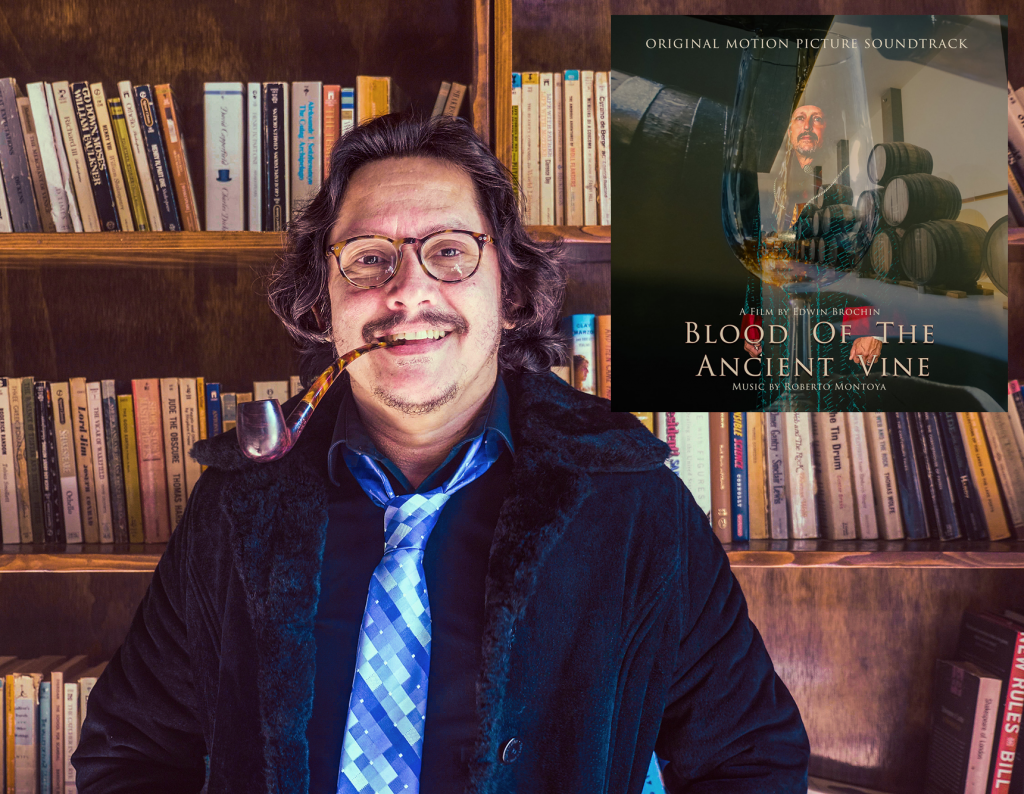By Keith Walsh
Rock and roller Roberto Montoya is known for his rock, gospel and electronica music in projects Icons Of Industry, Betamax Dub Machine and collaborations with RHYS. On his soundtrack to the fascinating new film Blood Of The Ancient Vine, branded with Icons Of Industry, Montoya and his collaborators João Martins, José Pedro Lima, and Nuno Silva explore the traditional music of The Iberian Peninsula, allowing Montoya a unique connection to his heritage. I asked Montoya about his work creating this brilliant set of songs. (My review of the album is here.)
Popular Culture Beat: From the first moments of the first track, with its strange cello variation on a distorted rock guitar riff, then almost immediately something Spanish in flavor joining in, I could tell this is a unique story about people and their experiences, about soul. How did your experience viewing the stories in the film inform your inspirations?
Roberto Montoya: I saw the trailer for the movie on a Facebook post saying that (Edwin Brochin) was working on a new documentary. I’d seen his previous films so I reached out to him and offered to do the score. His previous films used stock music, which isn’t uncommon for an indie documentary, so this would be his first project with an original score. He was excited about it and l. He sent me early drafts which were very long and rough but I got a sense of the project. I knew right away that I wanted music that was authentic and underscored the locations and experiences happening in the film.
Popular Culture Beat: How open was (director, narrator) Edwin Brochin to anything different, and how did that lead to a soundtrack that is wildly original while incorporating traditional music as well?
Roberto Montoya: The movie is about the history of Iberian wines but also about new business ventures so I wanted traditional music with modern elements. He liked the idea but when he heard some initial sketches he wasn’t sure if he wanted the entire score to be traditional music. He likes rock music and if you see his other films, they usually have hard rock music somewhere. As we developed the score and placed it on the timeline with the footage he realized that authentic and traditional Iberian music was the way to go. I made sure that we had some rock vibes too.
Popular Culture Beat: What influences did you pick up from your collaborators?
Roberto Montoya: My collaborators are amazing. They were selected because each one is a specialist in different genres of Iberian music. João Martins is fluent in Portuguese music, José Pedro Lima in flamenco and Spanish guitar, and Nuno Silva brings Arabic influences. I learned much about each of these styles by working with them.
Popular Culture Beat: How did you find that musical balance between bitterness and sweetness that is characteristic of wine?
Roberto Montoya: This came naturally from working in these traditional Iberian genres because the modes we used lend themselves to this balance. I think the Phrygian and Locrian modes are bittersweet.
Popular Culture Beat: Did you time each song or did the editor trim the audio?
Roberto Montoya: We wrote the score by writing to the early rough drafts. We knew that most of the footage in those early drafts would eventually get cut so we intentionally wrote pieces that could be moved around the timeline. Ideally you want to write to specific scenes but sometimes that isn’t an option so you adapt and accommodate. I sent the final mixes to the editor and he placed the music and trimmed the audio for the film. I did offer suggestions for specific segments.
Popular Culture Beat: The tunes “Fado no restaurante” and “Fado de Cornho” and “Fado De Vinho” have a pop, almost ragtime feel. What was the inspiration? What are some points of reference for you? Same question for the bulerías and the tango on the album.
Roberto Montoya: A fado is a traditional Portuguese style that dates back to the 1800’s. The pop and ragtime feel is part of that genre and João is a master. José Pedro is a skilled flamenco guitarist and he handled the bulerías, tangos, rumbas, and alegrías. These are traditional flamenco and Spanish genres. “Lluvia de Viñedo” (vineyard rain) is a piece that I initially wrote for the opening scene but after the final edits we decided to leave the opening scene without any music.
Popular Culture Beat: Is there a prepared piano on “Cañcao Popular ” (popular song) and “Pensativo?” If not, how did you achieve that sound? (I later apologized to Roberto for this misunderstanding, caused by headphones I was listening with adding color to the sound).
Roberto Montoya: “Canção Popular” which is actually translated from “folk song” doesn’t have any piano. That one is Portuguese guitar and oud. It also has adufe for the percussion. “Pensativo” and a few other tracks like “Rumba de la Uva” and “Albacete” do have piano. I played all the piano and synth parts and I used a Native Instruments Kontrol S49 with VST’s like Hybrid Keys for the piano parts.
Popular Culture Beat: In composing and mixing, what was your philosophy in regards to respecting traditional music while doing something modern?
Roberto Montoya: The composing was a joint effort between me and the other musicians. I wrote a few of the pieces from start to finish but the more traditional ones like the fados and flamenco were written by João and José Pedro. I provided guidance for mood and tempo but for the score to have real authenticity, each of us had to bring our specialties and strengths to the music. Nuno recorded them since they are all in Portugal. They came into his studio and I joined in on video conferences to work with them. He sent me all the raw tracks and I added various elements like strings, synths, piano, choir, and other textures to enhance and modernize the music a bit. I then mixed and mastered the final arrangements including adding effects.
Popular Culture Beat: Was the album mostly scored first, or mostly improvised? How long did it take from start to finish?
Roberto Montoya: Most of the music was scored to the drafts that we had initially but there was a lot of improvisation as well. For example, “Barrica de Vino Ibérico” (barrel of Iberian wine) is an improvisation by Nuno on oud. The score took about 2 months from start to finish.
Popular Culture Beat: How has working on this put you more in touch with your European roots and music from the Iberian peninsula, if at all?
Roberto Montoya: It’s interesting because I have both Spanish and Portuguese ancestry so I have Iberian roots but never tapped into that music until I started working on this film. I plan to continue developing that aspect of my playing and perhaps include it in some other projects.
Popular Culture Beat: On “Retrato De “Amália” there’s something like an eccentrically produced variation on a traditional folk music of Spanish guitar. At what point in composition did these types of decisions get made? I guess this applies to my question about the prepared piano as well.
Roberto Montoya: “Retrato de Amália” (portrait of Amália) was written for a scene where historian Carlos Evaristo is explaining the history of fado and its connection to wine. The scene takes place at a table inside the Castle of Ourém in Portugal and there’s a portrait of Amália Rodrigues, known as the “Queen of Fado,” on the table. The music was written for that scene and is inspired by medieval motifs and played on Portuguese guitar. I added tape echo and a bit of tube compression to enhance the eccentricity of the piece and give it a rock music vibe.
Popular Culture Beat: Had you all decided to make an experimental album from the start?
Roberto Montoya: My intention was to honor the authenticity of Iberian music but use experimental elements to make it original and contemporary.
Popular Culture Beat: How did you meet Silva, Pedro Lima, and Martins, and director Brochin for that matter?
Roberto Montoya: I’ve known director Brochin since we were in middle school. We grew up together and have been friends for years. I produced the theme music for one of his television shows. I met Nuno Silva a few years ago when we worked on an Icons of Industry song called Cedars of Lebanon. I found him when I was looking for a Persian instrumentalist for the song and he ended up playing the hammered dulcimer on it. He makes a cameo appearance in the music video. I reached out to Nuno for this project and he brought in João Martins and José Pedro Lima. I met them on this project.
Popular Culture Beat: What are all the instruments played on the album, particularly unusual ones, and which did you play?
Roberto Montoya: Some of the traditional instruments are Portuguese guitar, nylon string classical guitar, oud, hurdy gurdy, kanun, tar, and adufe. I played all the synth elements like cello, strings, and piano. I also used Native Instruments “Fables” and “Lores” to add ethereal and cinematic textures like angelic choirs, whispering vocals, and dramatic woodwinds.
Popular Culture Beat: Finally, please tell me about the circumstances of the recording, when, where, how, and what DAW etc?
Roberto Montoya: I used Ableton Live 11 for most of the writing and performing. I would load the video as a track which allowed me to write and record as I watched the footage. The video and music was synchronized so I could move around the timeline with the music locked in step. I would write a quick sketch with 2 or 3 movements and send it to Nuno. He would use that as inspiration and work with the rest of the team. I developed some of the sketches into complete pieces and those made it into the score. I used Luna by Universal Audio as my DAW for mixing and mastering. Nuno uses Reaper and has a similar workflow for writing and recording. Reaper also allows you to bring in video as a track to sync. João and José Pedro would come into Nuno’s studio on different days to record. This way they could focus on either Portuguese or Spanish music on that day.
Official Trailer For ‘Blood Of The Ancient Vine’
‘Blood Of The Sacred Vine’ IMDb
Edwin Brochin On IMDb
Roberto Montoya On IMDb
Official Dot Com
IndieFEST 2024
Icons Of Industry On Facebook
Album Review: ‘Blood Of The Ancient Vine’ Original Soundtrack
finis

